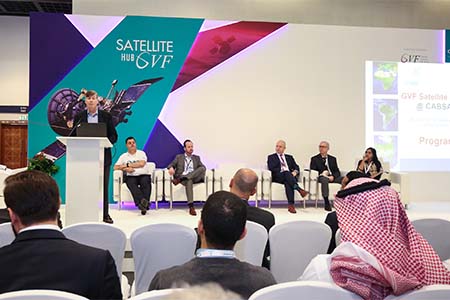 The GVF Satellite Hub Summit at CABSAT 2019 is one of the most important regional platforms delivered by GVF for MENA and South Asia. This year’s programme will be held on 12 and 13 March at an open-access theatre-style structure in the satellite exhibition halls. GVF will also host a half-day workshop on 14 March.
The GVF Satellite Hub Summit at CABSAT 2019 is one of the most important regional platforms delivered by GVF for MENA and South Asia. This year’s programme will be held on 12 and 13 March at an open-access theatre-style structure in the satellite exhibition halls. GVF will also host a half-day workshop on 14 March.
The programme will commence on 12 March with keynote presentations from the UAE Telecommunications Regulatory Authority (TRA) and the International Telecommunication Union (ITU). The remainder of the day will be taken up by the first two of four moderator-led, Q&A interactive panel sessions, with speakers first providing insights in the form of introductory and opening remarks, addressing the key issues pertinent to the strategic theme of their topic. The format then continues with panel discussion and audience interaction.
The 12 March programme features two sessions offering a broad and strategic overview of the satellite industry today. The first session encompasses everything from regulation, spectrum and interference, to cyber security, crisis connectivity, sustainable space, satellite and the cloud, M2M, IoT and 5G, grouped under the umbrella heading of Global Satellite Focus – “Big Ticket Issues.
The afternoon session, Global Satellite Business is Big Business – New Space Making It Bigger, will explore themes including UHTS and VHTS, evolution in the low- and medium-Earth orbit high throughput satellite environment, smallsat markets, ground segment dynamics, antenna design and engineering evolution, and the interfaces of satellite communications with Earth observation technology and applications.
The third and fourth sessions, on 13 March, will focus on important satellite communications solution user vertical markets in the mobility environment. One session will focus on maritime, which has a long legacy relationship with solutions in mobile satellite service (MSS), operating in L-band and now established as a strongly developing VSAT market. The other session will address the aeronautical connectivity and applications user vertical market, focusing on both the passenger experience of inflight entertainment and broadband connectivity and the essential contribution of satellite to ground and inflight operations.
The Maritime Morning theme, To the Wider Market and Service Horizon, will cover Maritime Mobility; Maritime Market Plurality; Key Facets of the User Experience; Bandwidth Inshore and on the High Seas; Satellite and Vessel Autonomy – Where? How? Why? And Satellite Cyber Security @ Sea, and Radomes and Superstructure Footprints.
The Aero Afternoon, It’s Not Just About the IFEC!, will cover specific themes such as Understanding New Segment Evolving Demand Dynamics, Aero: Frequency Dedicated or Frequency Agnostic?, Never Mind the Orbit: It’s all about the Price!, Hacking Aircraft Satcoms – Myth or Reality?, Always Online! Take-Up Rates by Captive Passengers or Demanding Customers?, How’s the Hardware Doing?, and Antennas – Conformal or What?
While mobility focus is immediately apparent in its exploration of the connectivity issues in today’s maritime and aeronautical markets, mobility factors now permeate multiple facets of dialogue on satcoms.
There are two principal, increasingly interconnected themes in today’s communications environment. One is evolution towards an integrated and unified broadband communications ecosystem. The second is development of technology platforms and service arrays which meet user markets’ demand for mobility, mobility and more mobility.
Exploration of key themes in technological development, as well as in service and market trends – on the path to a fully mobile broadband near-future founded on the complete integration of satellite and wireless – will reference the latest developments in the launch of more and more high-throughput (and very- and ultra-HTS) capacity to geosynchronous orbit, together with the expansion of HTS in MEO and LEO.
The Summit will also explore the strengths and weaknesses of current and developing satellite technologies in terms of providing access to the cloud. The cloud brings together different technologies – broadband networks, virtualisation, Web 2.0 interactivity, time sharing, browser interfaces – each a significant advance in its own right, but all the more powerful in combination.
In posing questions about satellite and the cloud, the Hub Summit objective is not to engage in a satellite-versus-terrestrial argument – particularly given the long-established trend of hybridised communications networks comprising satellite and terrestrial wireless technologies, and the immediate future of same, Rather, the objective is to identify exactly where the unique nature of satellite communications can contribute to greater functionality, reliability, ubiquity and connectivity to the cloud, not only for the globe’s most developed high-density markets, but also for the remote communities of the world’s emerging and developing economies and societies, and in the mobility space.
Machine-to-machine (M2M) communications is another focus, and the interface and synergy of M2M communications and satellite communications will be part of the event dialogue. This notes the longer-term significance of transitioning to Internet Protocol version 6 (IPv6), which will bring on the full potential of the Internet of Things (IoT)/Internet of Everything Everywhere (IoEE). The IoT/IoEE will be the ultimate realisation of a future universal M2M environment which will far exceed the potential boundaries and limited scope of even the greatest reach of the present-day M2M environment.
Globally, this market is growing fast, and the aggregated target markets make its potential for the satellite industry very important.
Regulation, spectrum and interference are topics central to dialogue on satellite and mobile wireless integration and the use and allocation of radio frequency bands. VHTS and UHTS, and the evolution in the LEO and MEO high-throughput satellite environment, together with ground segment dynamics and antenna engineering evolution, are key in discussing essential technology and service delivery for a physically more in-transit human population.
Martin Jarrold is Chief of International Programme Development at GVF and Chair of GVF Satellite Hub Summit at CABSAT 2019.












Add Comment